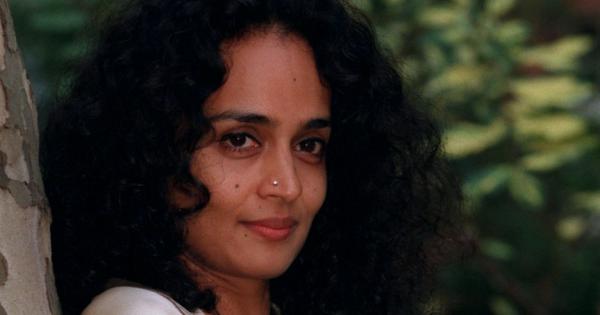
Like many others, I found myself devouring Arundhati Roy’s memoir Mother Mary Comes to Me. In recent years, Roy has rarely written such charming prose. Her sentences are clear as water. They flow with the freedom of a young river, as she recalls her unusual childhood – lived not like normal “mummy-daddy” kids but on the edge of respectability, perhaps not very far from privilege.
Her grief at the death of her mother sets Arundhati Roy off on this book. The remarkable Mary Roy, educationist and institution builder and slayer of patriarchal laws, is the subject of the first 100-odd disarming pages. But the title is a red herring; MR was no pious Mother Mary. Nor is this a misty-eyed elegy.
Wrath against motherhood
Mother Mary Comes to Me is Roy’s attempt to reach a reckoning with her mother’s rage, which bruised and scarred her children, to find a way to understand it. “Once I learned to protect myself (somewhat) from its soulcrushing meanness, I grew fascinated by her wrath against motherhood,” she writes.
I stopped at that phrase. I recognised it.
Motherhood is unacknowledged and unpaid labour. It damages women’s bodies and holds them back. Mothers are often poor, or made poorer – in time, mobility, opportunity – by having and caring for children. But through their whole lives, Indian women absorb its doctrine of self-denial, like raisins that plump up and turn shapeless in the water they are soaked in overnight.
The rage exists. Some swallow it, others reject the indoctrination.
Mary Roy clearly dropped out of the school for self-deprecating women early. In her daughter’s words, she conducted herself “with the edginess of a gangster.” Some of it was survival. She married the first man who proposed to her to escape a violent home run by a violent father. The husband turned out to be an alcoholic, leaving her to fend for herself and her two children. With little money and even less family support, she defied all odds, put them through boarding school and built the iconic school, Pallikoodam, in Kottayam, Kerala.
If Indian women are taught since childhood to whittle themselves into smaller and smaller versions, to not occupy the space entitled to men, Mary Roy brought all her selves to the table.
Roy writes with unconcealed admiration: “She unleashed all of herself – her genius, her eccentricity, her radical kindness, her militant courage, her ruthlessness, her generosity, her cruelty, her bullying, her head for business, and her wild, unpredictable temper” on the tiny Syrian Christian society of Kerala. Famously, she challenged the discriminatory provisions of the law that denied Syrian Christian women a substantial share in their father’s property – and won.
Mary Roy is a fascinating figure, and not just for a woman like me who has to fight her instincts to hide herself away. Her impulse to power, assertion and ambition, how she seemed not to waste one breath on pleasing people, is rare for Indian women. She brought down laws and raised institutions.
But the life of this folk-feminist hero is flecked with grey. As Mary Roy fought her way out of genteel poverty and opened up paths of liberation for her students, she turned on her children with fury. There were not just beatings and scoldings – common to parenting of a certain vintage – but verbal lashings that aimed at the fragile self-esteem of children. “It felt as though she had cut me out – cut my shape out – of a picture book with a sharp pair of scissors and then torn me up,” Roy writes.
One of the most disturbing passages of the book is Mary Roy taking her son to a separate room in the middle of the night, and breaking a wooden ruler on the silent child because he had returned with an “average” report card. The sister, who later gets hugs for a “brilliant report”, watches helplessly. It is an experience of injustice that, Arundhati Roy writes, attunes her forever to the wrongs around her. “On the occasions when I am toasted or applauded, I always feel that someone else, someone quiet, is being beaten in the other room. If you pause to think about it, it’s true, someone is.”
The cruelty makes for uncomfortable reading.
I have often thought of feminine rage as a powerful, subversive expression – a crack in the patriarchal wall, a burst of intemperate lightning that illuminates the chains that hold women in place.
But what if that anger is turned on the young and vulnerable? What if it drives you to reject love and care – roles which Mary Roy appeared to have outsourced to the coterie of less privileged women around her? “It was Kurusammal who taught us what love was,” Arundhati Roy writes, of a kind woman who took in the children in Ooty. “What dependability was. What being hugged was.”
There is a dialectical rhythm to the book, a tussle between the cruel and combustible mother remembered by a powerless child, and the fiercely original, almost Amazonian woman observed by the adult.
The adult would have you know that she has forgiven her mother, that she has resolved this tension. When her brother reminds her that “she treated nobody as badly as she treated you”, she writes, “But I had put that behind me a long time ago.”
At other places, she tries to explain away her mother’s behaviour. “Perhaps Mary Roy didn’t have many options,” she writes. “One of her school drivers said it best to me. ‘It’s only this crazy-lady style of Mrs Roy’s that will work in this Kottayam of ours.’”
Roy goes on: “Maybe he was right. She needed to be the way she was. I was just collateral for a more important enterprise. I was my problem, not hers. Fair enough.”
There is something about this forgiveness that, however, seems too easy, too pat. To write away yourself as “collateral” – what does it take?
Wrath against the mother
And it struck me that in a book that dwells on maternal cruelty, what is missing is the “wrath against the mother”. Even when Arundhati Roy leaves her mother’s home for seven years, it is not framed as an act of anger – but of survival. The only point at which we see Roy lose it is years later, when Mary Roy is ageing and unwell, and in a drug-addled state. Even here, the daughter does not strike out in her own defence. Instead, it is Mary Roy’s uncharacteristically casteist abuse that flips a switch. “Without realising what I was doing, I picked up the chair near her bed and smashed it down…It was the first and only time in all my life with my mother that I had reacted spontaneously.”
It is a loss of control that is never repeated in the narrative. Nor is there much reflection of what growing up with a difficult, angry mother would have done to her. Did she inherit her mother’s fury or did she never allow herself the space to be furious? What did it take out of her to forgive her mother? Did it not involve dredging up the resentments, grievances and some ugly feelings? Mother Mary Comes to Me never takes the reader into that messy terrain.
Early on in the book, Arundhati Roy writes: “In my effort to fathom my mother, to see things from her perspective, to accommodate her … I turned into a maze. Seeing her through lenses that were not entirely coloured by my own experience of her made me value her for the woman she was. It made me a writer. A novelist. Because that’s what novelists are – labyrinths.”
It’s a beautiful articulation of the leap of empathy that the novelist must necessarily take – to find the richer truth, beyond hard-edged certainties of conscious beliefs. “Read this book like a novel,” Arundhati Roy exhorts the reader. “It makes no greater claim.”
But if Mary Roy is a character in this novel, it is one drawn in exceedingly broad strokes.
I imagined a towering figure, an important figure – given to tantrums and sharp diktats and used to complete subservience. A woman without a back story, without a sense of who she came from, without an interior life. I found myself thinking of another Indian writer’s book on his parents – Jeet Thayil’s The Elsewhereans, which begins with a delightful portrait of his parents long before he was born, which decentres the child to give space to the mother. The writer goes on a journey filled with curiosity and love into what made and unmade his parents.
Mary Roy, though nominally the subject of her daughter’s book, does not get the grace of that attention. Perhaps, she did not deserve it. Fair enough.
For a story of a fraught, spiky relationship, Arundhati Roy’s Mother Mary Comes to Me is filled with joy, arch humour and disorienting grief. But it does withhold something – call it forgiveness.
Also read:
‘Mother Mary Comes To Me’: Arundhati Roy writes intimately of life with, and without, her mother
This article was first published on the author’s Substack, Of No Fixed Address.
Mother Mary Comes to Me, Arundhati Roy, Penguin Random House.
📰 Crime Today News is proudly sponsored by DRYFRUIT & CO – A Brand by eFabby Global LLC
Design & Developed by Yes Mom Hosting






